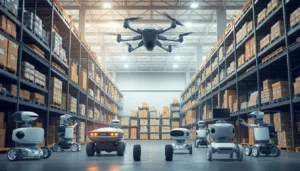In a world where robots are no longer just the stuff of sci-fi movies, robotics automation is taking center stage. Imagine a workplace where tasks are handled faster than you can say “artificial intelligence.” It’s not just about efficiency; it’s about freeing humans from the mundane so they can focus on what really matters—like perfecting their coffee-making skills or finally getting around to that long-overdue office party.
Robotics automation isn’t just a trend; it’s a revolution. Businesses are jumping on the bandwagon, eager to embrace technology that can boost productivity and cut costs. So whether you’re a tech enthusiast or a curious bystander, understanding the ins and outs of robotics automation could be your ticket to the future. After all, who wouldn’t want a robot buddy to help tackle the daily grind?
Table of Contents
ToggleOverview Of Robotics Automation
Robotics automation revolutionizes workplace dynamics, streamlining operations and enhancing productivity. Understanding its nuances is vital for adapting to the future landscape of work.
Definition And Importance
Robotics automation refers to employing robotic systems to perform tasks typically handled by humans. This technology plays a crucial role in increasing operational efficiency and reducing human error. Companies leverage robotics automation to cut costs and optimize resource allocation. It enables workers to focus on strategic tasks rather than mundane chores. Industries such as manufacturing, healthcare, and logistics have integrated automation to remain competitive. Staying informed about robotics automation ensures that professionals keep pace with technological advancements.
Key Components
Several critical components form the foundation of robotics automation systems. Sensors collect real-time data, allowing robots to navigate and respond to their environments. Actuators control movements, enabling precise actions within various tasks. Controller units process information and direct the robotic functions, making decisions based on sensor input. Software algorithms facilitate programming and optimization, ensuring efficient task execution. Communication interfaces connect robotic systems to broader networks, allowing seamless integration with other technologies. Together, these components create advanced robotics systems that redefine productivity and efficiency.
Applications Of Robotics Automation
Robotics automation plays a vital role across various industries, fundamentally altering how tasks are performed. Its applications span manufacturing, healthcare, and logistics, each benefiting from increased efficiency and improved outcomes.
Manufacturing Industry
Manufacturing relies heavily on robotics automation for precision and speed. Robots assemble, weld, and package products, enhancing productivity levels. For instance, automotive factories utilize robotic arms for assembling components, improving accuracy while minimizing human error. Such systems operate with remarkable consistency, significantly reducing cycle times. Moreover, automation helps in managing quality control, ensuring that products meet industry standards.
Healthcare Sector
In healthcare, robotics automation optimizes patient care and operational efficiency. Surgical robots assist doctors in performing intricate procedures with precision. Cancer treatment centers employ automated systems for delivering radiation therapy, minimizing exposure to healthy tissues. Additionally, robotic devices streamline tasks like medication dispensing and patient monitoring, allowing healthcare professionals to focus on critical patient interactions. This technological advancement increases the overall effectiveness of healthcare delivery.
Logistics And Warehousing
Logistics and warehousing benefit immensely from robotics automation through enhanced inventory management. Automated guided vehicles transport goods within warehouses, reducing reliance on human labor. Sorting systems efficiently categorize products, speeding up order fulfillment processes. Data indicates that companies implementing automation in their logistics reduce shipping times by up to 30%. These systems also provide real-time tracking updates, ensuring timely delivery and improved customer satisfaction.
Benefits Of Robotics Automation
Robotics automation offers numerous advantages that significantly enhance workplace operations.
Increased Efficiency
Robots perform repetitive tasks at a consistent speed without fatigue. Industries leveraging robotics often report production rates that are 20% to 50% higher compared to manual labor. Automation reduces downtime, resulting in streamlined operations. Tasks that once took hours can now be completed in minutes. With robots taking on mundane activities, human workers can allocate time to more complex projects. Workflow optimizations become straightforward, leading to improved overall productivity.
Improved Precision
Robotics systems excel in precision, reducing errors during tasks. For example, robots in manufacturing ensure that assembly processes meet exact specifications. Studies show that automation can cut error rates by up to 90%. Enhanced accuracy translates to quality control, minimizing waste and rework. Automated systems follow programmed instructions flawlessly, maintaining consistent quality across batches. Consequently, businesses enjoy higher customer satisfaction due to superior product reliability.
Cost Reduction
Integrating robotics automation can yield significant cost savings for businesses. Many companies reduce labor costs by 30% to 50% when transitioning to automated systems. Robots enhance operational efficiency, leading to lower production costs over time. Additionally, minimizing human error decreases expenses associated with defective products. Long-term investments in robotics often pay off through increased output and reduced labor costs. Firms that adopt automation often find themselves better positioned to compete in the market.
Challenges And Limitations
Robotics automation presents several challenges that businesses must navigate to fully leverage its benefits. Understanding these obstacles is essential for organizations aiming to adopt this technology effectively.
Technical Barriers
Integration complexities often arise when implementing robotics automation systems. Compatibility issues between existing infrastructure and new robotic solutions can hinder efficiency gains. Maintenance requirements for sophisticated robotic systems also demand specialized knowledge, which may not be readily available in-house. Furthermore, high initial investment costs can discourage some enterprises from pursuing automation, despite potential long-term savings and higher productivity. Addressing these technical barriers is crucial for organizations striving to remain competitive.
Workforce Impact
The introduction of robotics automation significantly alters workforce dynamics. Job displacement may occur as machines take over repetitive tasks previously performed by humans. However, new job opportunities can emerge in areas like robot programming and maintenance. Upskilling the existing workforce becomes essential to mitigate the effects of automation on employment. Companies that invest in training programs provide employees with the skills needed to operate alongside robotic systems. This balanced approach helps create a collaborative environment that maximizes the benefits of robotics automation while reducing potential negative impacts on the workforce.
Future Trends In Robotics Automation
Robotics automation continues to evolve rapidly, introducing innovative solutions and capabilities across various industries. Significant trends are shaping the future of this technology.
AI Integration
AI integration enhances robotics automation by enabling machines to learn from data and improve their performance over time. Intelligent algorithms allow robots to adapt to changing environments and make decisions autonomously. With machine learning, automation systems can analyze patterns, enhancing precision and efficiency. For instance, AI-equipped robots in manufacturing can predict equipment failures, minimizing downtime. Additionally, robots can optimize workflows through real-time data analysis, driving productivity in operations. As AI continues to progress, the synergy between AI and robotics will lead to unprecedented advancements in automation capabilities.
Collaborative Robots (Cobots)
Collaborative robots, or cobots, foster seamless human-robot interaction in the workplace. Unlike traditional robots that operate independently, cobots work alongside humans, enhancing efficiencies without replacing jobs. Their design emphasizes safety, as cobots can detect human presence and adjust their operations accordingly. In assembly lines, cobots assist workers in tedious tasks, allowing humans to focus on complex components. These robots provide flexibility, adapting to various tasks without major reprogramming efforts. Their growing implementation in factories and service sectors showcases how cobots are transforming the dynamics of teamwork and enhancing productivity.
Robotics automation is not just a passing trend; it’s a fundamental shift in how industries operate. As businesses increasingly embrace this technology, the potential for enhanced efficiency and productivity becomes clearer. By automating routine tasks, companies can empower their workforce to engage in more meaningful work, ultimately driving innovation and growth.
The integration of robotics automation presents both challenges and opportunities. While initial costs and workforce impacts must be managed, the long-term benefits far outweigh these concerns. As the technology continues to evolve, staying informed and adapting to these changes will be crucial for professionals across all sectors. Embracing robotics automation is essential for those looking to thrive in an ever-changing business landscape.










